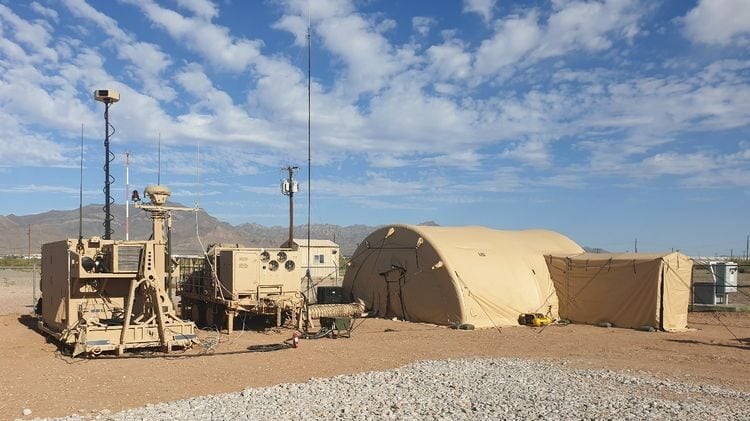ASHLEY ROQUE

An IBCS engagement operations center set up at White Sands Missile Range, New Mexico, for the limited user test in 2020. (US Army)
WASHINGTON — Pentagon acquisition authorities have approved full-rate production for the Army’s delayed Integrated Battle Command System, the service announced on Wednesday, a move that enables it to proceed producing the centerpiece of its air and missile defense modernization strategy.
The Army’s IBCS is billed as the command-and-control heart of its air and missile defense architecture, but the program has been plagued with technical delays as the Army expanded the mission set and necessary capabilities over the years. However, this week’s announcement signifies Pentagon approval of program improvements, in part, because Under Secretary of Defense for Acquisition and Sustainment William LaPlante is the one who made the call.
Prime contractor Northrop Grumman said in a statement today, “The full-rate production decision enables the US Army to set the fielding schedule for IBCS to operational air defense units.”
It also noted that this week’s decision paves the path for future foreign military sales, like Poland’s decision to acquire the IBCS to support its Patriot air defense systems, which was approved by the US back in 2017.
“Poland selected IBCS to serve as the centerpiece of the country’s air and missile defense modernization, and as it is adopted by more US allies and partners, IBCS will enable high levels of coalition forces interoperability and network integration,” Northrop said.
IBCS work began in 2009 but the program hit numerous hurdles along the way including a disastrous limited user test in 2016 that forced the Army to reboot the program. The service then gave that test another go in 2020 and dubbed it a “success.” The Pentagon’s chief weapons tester later agreed that “preliminary indications show improved reliability and stability from the previous LUT” while also noting some areas ripe for improvement.
“Deficiencies in the flight mission simulator/digital and launcher on the net tools, used to simulate Patriot radars and launchers, are causing problems which degrade the ability to adequately assess system effectiveness,” the Director, Operational Test & Evaluation (DOT&E) wrote in its fiscal 2020 report. “The office also noted that the single integrated air picture was inconsistent across the engagement operations centers during this event.
Following that second limited user test, the service embarked on a plan of action to get its IBCS ready for the initial operational test and evaluation (IOT&E), which would be critical for helping LaPlant decide if the capability was ready for full-rate production.
That crucial test was completed late last year and DOT&E said in its most recent report, released in January and based on test events occurring in fiscal 2022, that it will not publicly publish its final IOT&E assessment until next year. However, it noted that the event was broken up into two phases and between phase 1 and 2 the Army modified software to mitigate “system limitations caused by known software deficiencies.”
It also recommended that the Army develop an integrated suite of modeling and simulation for follow-on testing as the service continues to experiment with existing and future launchers, sensors, and other systems.
Although DOT&E’s final assessment of IBCS testing is not publicly available, it noted that it would send Pentagon acquisition authorities, like LaPlante, a “classified” version of its findings to help make their production decision. Wednesday’s announcement suggests things went fairly well.
“Navigating a successful (full-rate production decision defense acquisition board) is truly a monumental accomplishment for the collective team,” Col. Chris Hill, project manager of the Integrated Fires Mission Command Project Office, said in a statement on Wednesday.
“Our soldiers’ and civilians’ dedication, expertise, and collaboration with industry and the stakeholder community has paved the way for a more effective and coordinated capability against complex air and missile threats that will serve our Army and joint force for decades to come,” he added.
No comments:
Post a Comment